Analyzing Nestle's Ethical Practices Using Carroll's Pyramid
VerifiedAdded on 2023/04/20
|9
|1920
|279
Case Study
AI Summary
This case study examines Nestle's ethical practices, focusing on its marketing of breast milk substitutes and its adherence to corporate social responsibility (CSR) principles. The analysis utilizes Carroll's Pyramid, dissecting the company's economic, legal, ethical, and philanthropic responsibilities. The study explores Nestle's financial performance, legal and regulatory compliance, and ethical considerations, including stakeholder opinions and the impact of misleading marketing claims. It assesses the company's fulfillment of its ethical obligations, considering the limitations of the Carroll's Pyramid model and the balance between shareholder value and societal impact. The case study concludes by evaluating whether Nestle meets its ethical obligations regarding the specific issue, highlighting the complexities of corporate responsibility in a global context.
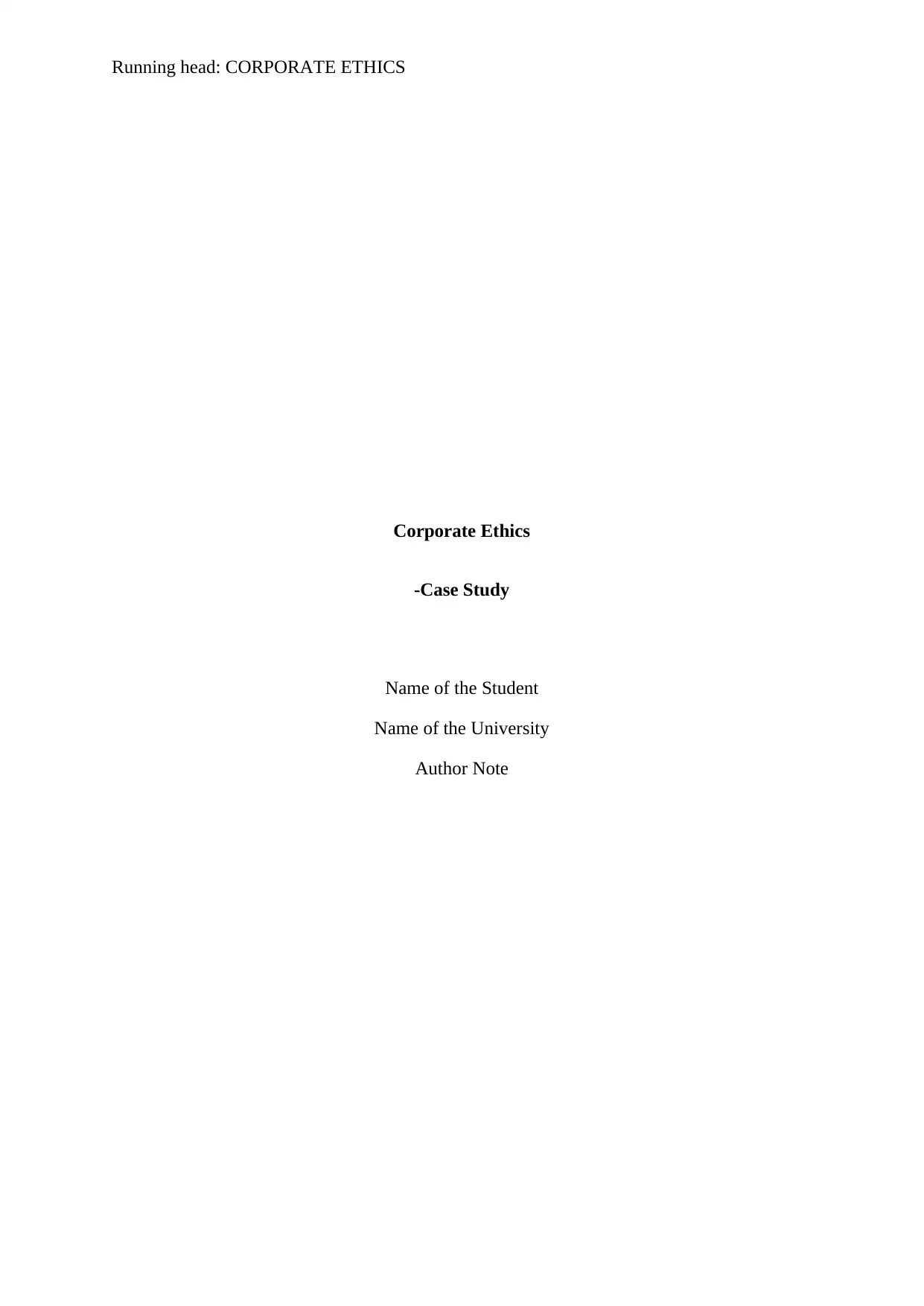
Running head: CORPORATE ETHICS
Corporate Ethics
-Case Study
Name of the Student
Name of the University
Author Note
Corporate Ethics
-Case Study
Name of the Student
Name of the University
Author Note
Paraphrase This Document
Need a fresh take? Get an instant paraphrase of this document with our AI Paraphraser
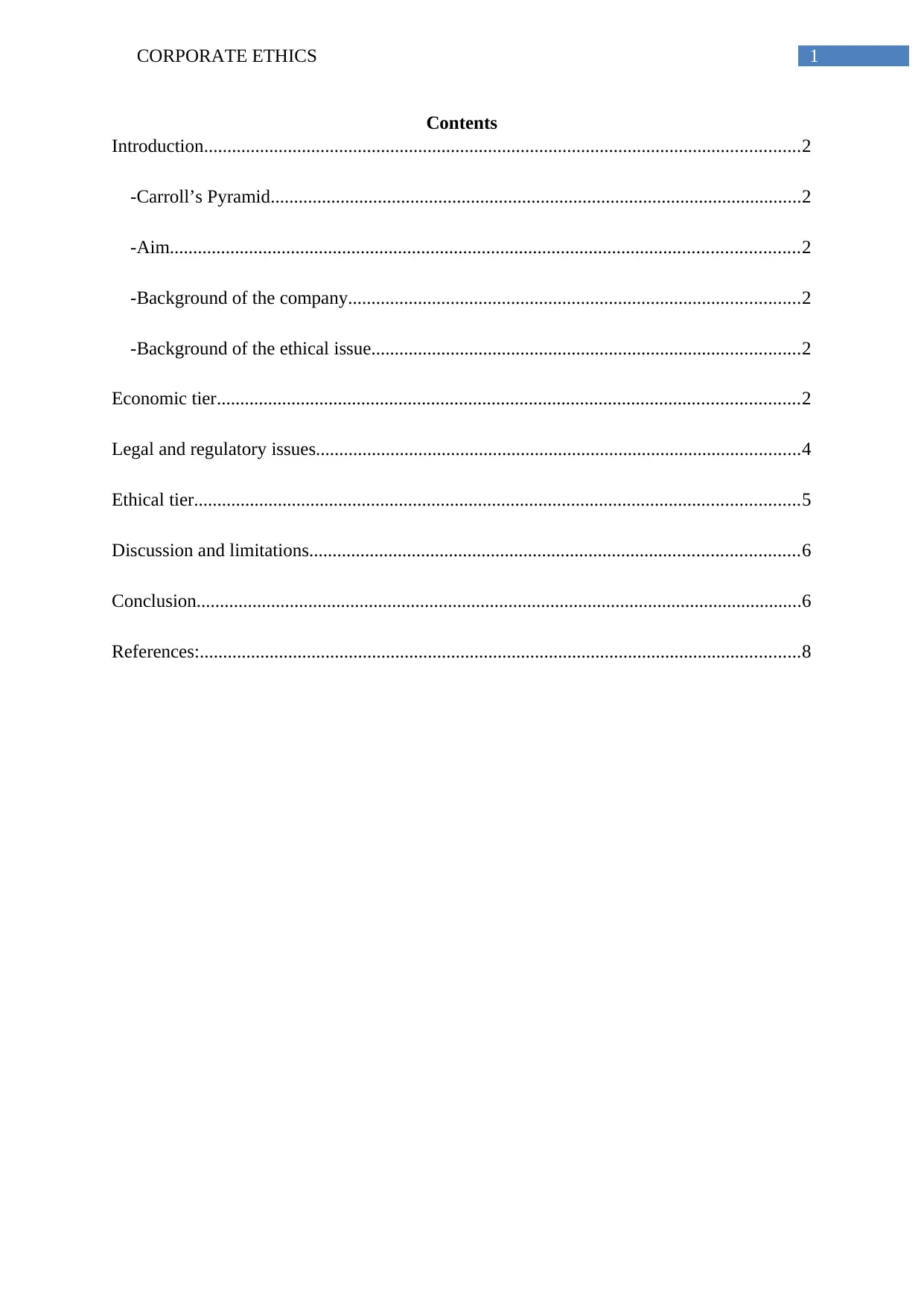
1CORPORATE ETHICS
Contents
Introduction................................................................................................................................2
-Carroll’s Pyramid..................................................................................................................2
-Aim.......................................................................................................................................2
-Background of the company.................................................................................................2
-Background of the ethical issue............................................................................................2
Economic tier.............................................................................................................................2
Legal and regulatory issues........................................................................................................4
Ethical tier..................................................................................................................................5
Discussion and limitations.........................................................................................................6
Conclusion..................................................................................................................................6
References:.................................................................................................................................8
Contents
Introduction................................................................................................................................2
-Carroll’s Pyramid..................................................................................................................2
-Aim.......................................................................................................................................2
-Background of the company.................................................................................................2
-Background of the ethical issue............................................................................................2
Economic tier.............................................................................................................................2
Legal and regulatory issues........................................................................................................4
Ethical tier..................................................................................................................................5
Discussion and limitations.........................................................................................................6
Conclusion..................................................................................................................................6
References:.................................................................................................................................8
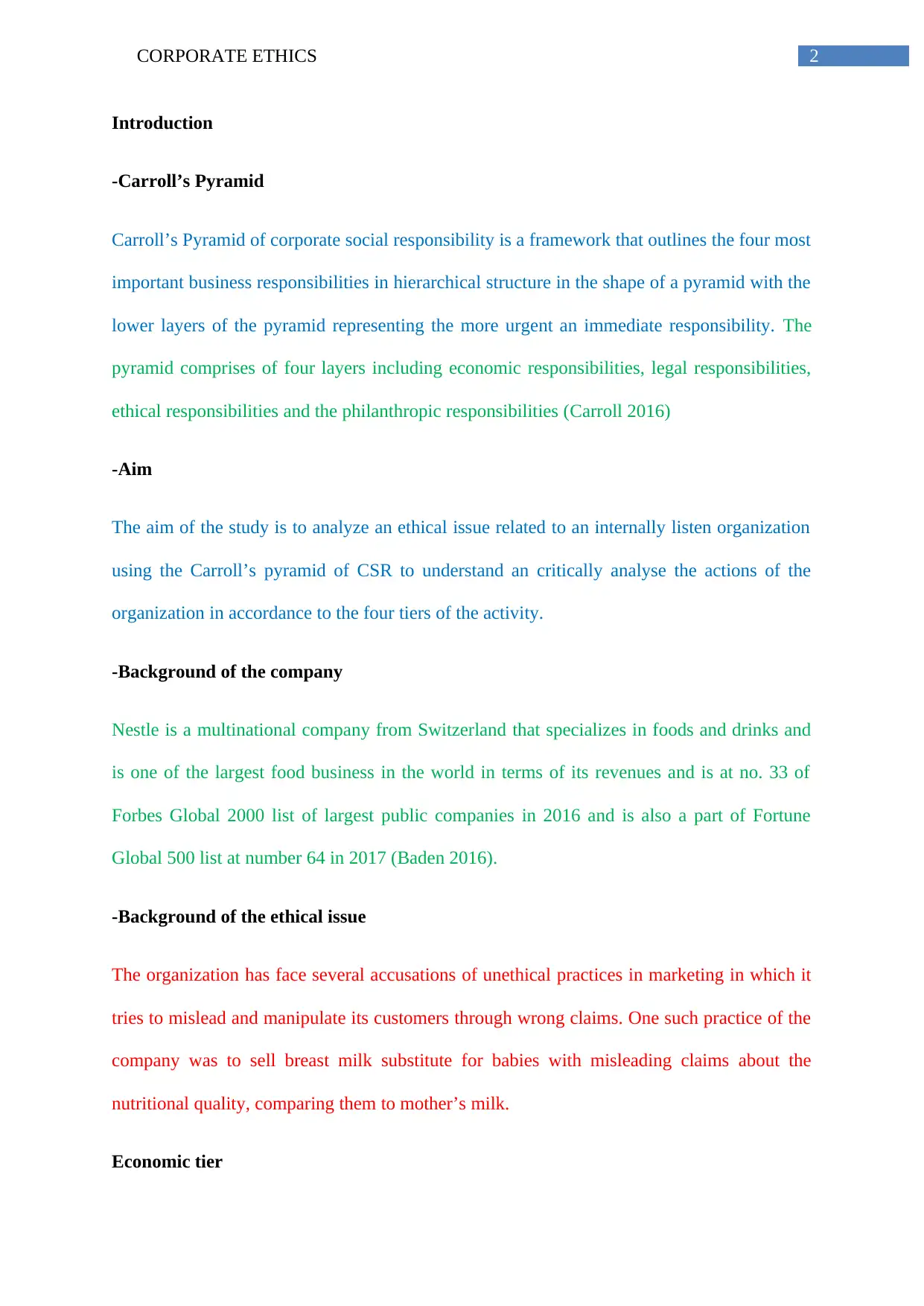
2CORPORATE ETHICS
Introduction
-Carroll’s Pyramid
Carroll’s Pyramid of corporate social responsibility is a framework that outlines the four most
important business responsibilities in hierarchical structure in the shape of a pyramid with the
lower layers of the pyramid representing the more urgent an immediate responsibility. The
pyramid comprises of four layers including economic responsibilities, legal responsibilities,
ethical responsibilities and the philanthropic responsibilities (Carroll 2016)
-Aim
The aim of the study is to analyze an ethical issue related to an internally listen organization
using the Carroll’s pyramid of CSR to understand an critically analyse the actions of the
organization in accordance to the four tiers of the activity.
-Background of the company
Nestle is a multinational company from Switzerland that specializes in foods and drinks and
is one of the largest food business in the world in terms of its revenues and is at no. 33 of
Forbes Global 2000 list of largest public companies in 2016 and is also a part of Fortune
Global 500 list at number 64 in 2017 (Baden 2016).
-Background of the ethical issue
The organization has face several accusations of unethical practices in marketing in which it
tries to mislead and manipulate its customers through wrong claims. One such practice of the
company was to sell breast milk substitute for babies with misleading claims about the
nutritional quality, comparing them to mother’s milk.
Economic tier
Introduction
-Carroll’s Pyramid
Carroll’s Pyramid of corporate social responsibility is a framework that outlines the four most
important business responsibilities in hierarchical structure in the shape of a pyramid with the
lower layers of the pyramid representing the more urgent an immediate responsibility. The
pyramid comprises of four layers including economic responsibilities, legal responsibilities,
ethical responsibilities and the philanthropic responsibilities (Carroll 2016)
-Aim
The aim of the study is to analyze an ethical issue related to an internally listen organization
using the Carroll’s pyramid of CSR to understand an critically analyse the actions of the
organization in accordance to the four tiers of the activity.
-Background of the company
Nestle is a multinational company from Switzerland that specializes in foods and drinks and
is one of the largest food business in the world in terms of its revenues and is at no. 33 of
Forbes Global 2000 list of largest public companies in 2016 and is also a part of Fortune
Global 500 list at number 64 in 2017 (Baden 2016).
-Background of the ethical issue
The organization has face several accusations of unethical practices in marketing in which it
tries to mislead and manipulate its customers through wrong claims. One such practice of the
company was to sell breast milk substitute for babies with misleading claims about the
nutritional quality, comparing them to mother’s milk.
Economic tier
⊘ This is a preview!⊘
Do you want full access?
Subscribe today to unlock all pages.

Trusted by 1+ million students worldwide

3CORPORATE ETHICS
The current share price of Nestle is 100.82 USD which has improved from its year low price
of 72.92USD. The price of Nestle shares have increased significantly over the last six months
and over a period from 1998 to 2017 the share prices of the organization consistently
increased from 21.19 USD to 73.95 USD. This shows a considerable generation of wealth
and dividend for its shareholders. The organization uses key strategies such as Returning cash
to its shareholders in cases where value creating opportunities for investments are not found
thereby promoting better relations with the shareholders and showing concern for their
investments. The organization also provides the senior executives and CEOs in their abilities
to deliver long terms returns thereby promoting excellence in performance among them.
Additionally the organization rewards the middle management as well as the front line
employees for superior performance that directly influences organizational performance and
create shareholder value.
The ethical issue discussed in the given study can adversely affect the organization’s image
and therefore is relation with the stakeholders and value for the shareholders. An adverse
impact on the brand image can reduce the share prices which was seen between November
2018 and January 2019, during which the price of the shares dropped from 85.4 to 78.9USD.
The ethical issue can also cause a reduction in organization’s profitability and revenue
generation (Ehie 2016).
The issue has resulted in the development of policies and practices within Nestle to use
stronger monitoring systems for its marketing approaches and ensure ethical marketing
strategies by the organization. The company however has been able to create significant
wealth for its shareholders by maintain its ability to have an increase its share prices over the
years and therefore create wealth for shareholders. Thus it can be understood that even
though the unethical marketing practice can adversely impact the marketing effectiveness and
brand image of the organization, on an overall scale the organization has been successful in
The current share price of Nestle is 100.82 USD which has improved from its year low price
of 72.92USD. The price of Nestle shares have increased significantly over the last six months
and over a period from 1998 to 2017 the share prices of the organization consistently
increased from 21.19 USD to 73.95 USD. This shows a considerable generation of wealth
and dividend for its shareholders. The organization uses key strategies such as Returning cash
to its shareholders in cases where value creating opportunities for investments are not found
thereby promoting better relations with the shareholders and showing concern for their
investments. The organization also provides the senior executives and CEOs in their abilities
to deliver long terms returns thereby promoting excellence in performance among them.
Additionally the organization rewards the middle management as well as the front line
employees for superior performance that directly influences organizational performance and
create shareholder value.
The ethical issue discussed in the given study can adversely affect the organization’s image
and therefore is relation with the stakeholders and value for the shareholders. An adverse
impact on the brand image can reduce the share prices which was seen between November
2018 and January 2019, during which the price of the shares dropped from 85.4 to 78.9USD.
The ethical issue can also cause a reduction in organization’s profitability and revenue
generation (Ehie 2016).
The issue has resulted in the development of policies and practices within Nestle to use
stronger monitoring systems for its marketing approaches and ensure ethical marketing
strategies by the organization. The company however has been able to create significant
wealth for its shareholders by maintain its ability to have an increase its share prices over the
years and therefore create wealth for shareholders. Thus it can be understood that even
though the unethical marketing practice can adversely impact the marketing effectiveness and
brand image of the organization, on an overall scale the organization has been successful in
Paraphrase This Document
Need a fresh take? Get an instant paraphrase of this document with our AI Paraphraser

4CORPORATE ETHICS
maintaining the profitability as well as wealth of its shareholders by maintain its marketing
position as well as stock prizes (Deigh et al. 2016).
Legal and regulatory issues
In context of the given ethical issue the following legal an regulatory policies can be applied
as discussed below:
Advertisement Standard Authority (ASA) policy: this policy implies the responsibility
of the organization to use standard practices in advertising by following the
advertising code developed by the committee of advertising practice.
UK Code of Non-broadcast Advertising, Sales Promotion and Direct Marketing (CAP
Code): this provides CAP non broadcast codes to include non-broadcast advertising
such as print and online for sales promotion. The code focuses to the enforcement of
honesty and accuracy in advertisements and provides specific conditions related to
advertisements made for children .
Chartered Institute of Public Relations Code (CIPR) : CIPR provides a code of
conduct for best practice guidelines in public relations and marketing which includes
the involvement of inclusive communications and sets standards for communication
with children requiring special considerations to be met by the business.
Direct Marketing Association Policies: this policies influence all forms of direct
marketing as well as acting in a way to market products to consumers and implies
maintenance of strict codes while maintaining relationship with the customers.
(Kumar 2017)
Analysis of the case study on the ethical issues for Nestle shows that the organization has
not been able to follow the codes of conduct amd standard practices set out by ASA, CAP
maintaining the profitability as well as wealth of its shareholders by maintain its marketing
position as well as stock prizes (Deigh et al. 2016).
Legal and regulatory issues
In context of the given ethical issue the following legal an regulatory policies can be applied
as discussed below:
Advertisement Standard Authority (ASA) policy: this policy implies the responsibility
of the organization to use standard practices in advertising by following the
advertising code developed by the committee of advertising practice.
UK Code of Non-broadcast Advertising, Sales Promotion and Direct Marketing (CAP
Code): this provides CAP non broadcast codes to include non-broadcast advertising
such as print and online for sales promotion. The code focuses to the enforcement of
honesty and accuracy in advertisements and provides specific conditions related to
advertisements made for children .
Chartered Institute of Public Relations Code (CIPR) : CIPR provides a code of
conduct for best practice guidelines in public relations and marketing which includes
the involvement of inclusive communications and sets standards for communication
with children requiring special considerations to be met by the business.
Direct Marketing Association Policies: this policies influence all forms of direct
marketing as well as acting in a way to market products to consumers and implies
maintenance of strict codes while maintaining relationship with the customers.
(Kumar 2017)
Analysis of the case study on the ethical issues for Nestle shows that the organization has
not been able to follow the codes of conduct amd standard practices set out by ASA, CAP
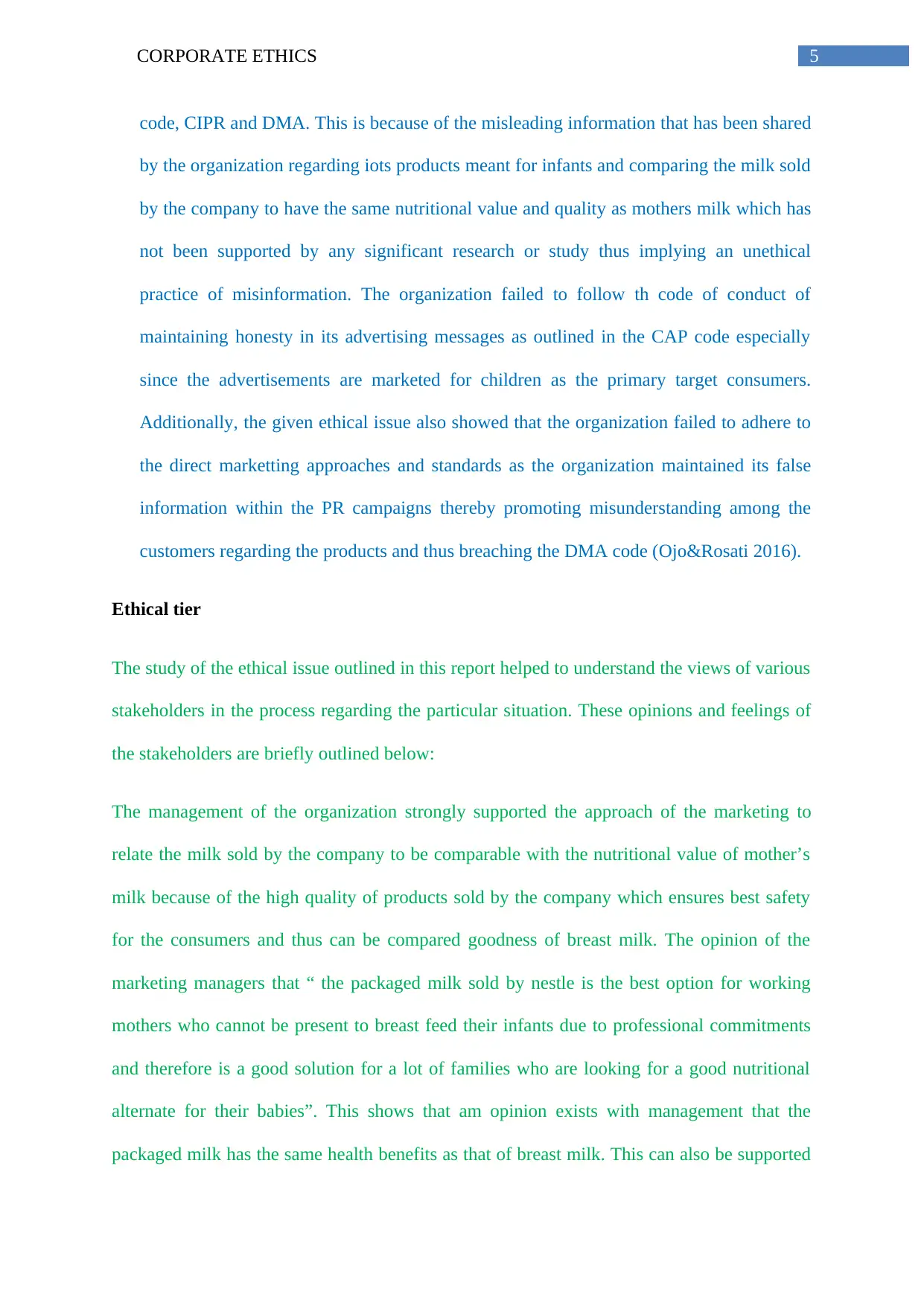
5CORPORATE ETHICS
code, CIPR and DMA. This is because of the misleading information that has been shared
by the organization regarding iots products meant for infants and comparing the milk sold
by the company to have the same nutritional value and quality as mothers milk which has
not been supported by any significant research or study thus implying an unethical
practice of misinformation. The organization failed to follow th code of conduct of
maintaining honesty in its advertising messages as outlined in the CAP code especially
since the advertisements are marketed for children as the primary target consumers.
Additionally, the given ethical issue also showed that the organization failed to adhere to
the direct marketting approaches and standards as the organization maintained its false
information within the PR campaigns thereby promoting misunderstanding among the
customers regarding the products and thus breaching the DMA code (Ojo&Rosati 2016).
Ethical tier
The study of the ethical issue outlined in this report helped to understand the views of various
stakeholders in the process regarding the particular situation. These opinions and feelings of
the stakeholders are briefly outlined below:
The management of the organization strongly supported the approach of the marketing to
relate the milk sold by the company to be comparable with the nutritional value of mother’s
milk because of the high quality of products sold by the company which ensures best safety
for the consumers and thus can be compared goodness of breast milk. The opinion of the
marketing managers that “ the packaged milk sold by nestle is the best option for working
mothers who cannot be present to breast feed their infants due to professional commitments
and therefore is a good solution for a lot of families who are looking for a good nutritional
alternate for their babies”. This shows that am opinion exists with management that the
packaged milk has the same health benefits as that of breast milk. This can also be supported
code, CIPR and DMA. This is because of the misleading information that has been shared
by the organization regarding iots products meant for infants and comparing the milk sold
by the company to have the same nutritional value and quality as mothers milk which has
not been supported by any significant research or study thus implying an unethical
practice of misinformation. The organization failed to follow th code of conduct of
maintaining honesty in its advertising messages as outlined in the CAP code especially
since the advertisements are marketed for children as the primary target consumers.
Additionally, the given ethical issue also showed that the organization failed to adhere to
the direct marketting approaches and standards as the organization maintained its false
information within the PR campaigns thereby promoting misunderstanding among the
customers regarding the products and thus breaching the DMA code (Ojo&Rosati 2016).
Ethical tier
The study of the ethical issue outlined in this report helped to understand the views of various
stakeholders in the process regarding the particular situation. These opinions and feelings of
the stakeholders are briefly outlined below:
The management of the organization strongly supported the approach of the marketing to
relate the milk sold by the company to be comparable with the nutritional value of mother’s
milk because of the high quality of products sold by the company which ensures best safety
for the consumers and thus can be compared goodness of breast milk. The opinion of the
marketing managers that “ the packaged milk sold by nestle is the best option for working
mothers who cannot be present to breast feed their infants due to professional commitments
and therefore is a good solution for a lot of families who are looking for a good nutritional
alternate for their babies”. This shows that am opinion exists with management that the
packaged milk has the same health benefits as that of breast milk. This can also be supported
⊘ This is a preview!⊘
Do you want full access?
Subscribe today to unlock all pages.

Trusted by 1+ million students worldwide

6CORPORATE ETHICS
by the views and research and development managers who feel that that no harm has been
ever recorded on the health of children from drinking nestle milk (Wagner-Tsukamoto 2016).
Discussion and limitations
From the above study it can be seen that Nestle has been able to fulfill its economic tier by
providing value and wealth for all its shareholders. However, at a legal and regulatory tier, it
failed to address the key regulations and laws and policies. Moreover, at an ethical tier, the
organizational has been able to justify its actions even though a mixed reaction exists within
the customers regarding the practice. Moreover, it can also be added that the activity of nestle
in context of the fourth and final tier of the Carroll’s pyramid which id philanthropic tier has
not been addressed and met in regard to this issue (Ehie 2016).
One significant limitation of this research is the dependency on secondary data due to which
the accuracy of the information is significantly dependent on the accuracy of the source
material. Another limitation which is significant, is inherent within the pyramid model that
tries to place the complexity of human emotion on discreet tiers instead of inter related tiers
since economic, regulatory, legal and ethical factors can have inter related impacts (Carroll
2016).
Conclusion
From the above study it can be concluded that the organization has not been able to fulfill its
ethical obligations as outlined by the Carroll’s pyramid model even though the management
of the organization is quiet convinced about the accuracy and harmlessness of its advertising
message the lack of solid evidence prove their marketing claim only suggests that the
information has been developed as a gimmick to fool an mislead the customers. The views of
by the views and research and development managers who feel that that no harm has been
ever recorded on the health of children from drinking nestle milk (Wagner-Tsukamoto 2016).
Discussion and limitations
From the above study it can be seen that Nestle has been able to fulfill its economic tier by
providing value and wealth for all its shareholders. However, at a legal and regulatory tier, it
failed to address the key regulations and laws and policies. Moreover, at an ethical tier, the
organizational has been able to justify its actions even though a mixed reaction exists within
the customers regarding the practice. Moreover, it can also be added that the activity of nestle
in context of the fourth and final tier of the Carroll’s pyramid which id philanthropic tier has
not been addressed and met in regard to this issue (Ehie 2016).
One significant limitation of this research is the dependency on secondary data due to which
the accuracy of the information is significantly dependent on the accuracy of the source
material. Another limitation which is significant, is inherent within the pyramid model that
tries to place the complexity of human emotion on discreet tiers instead of inter related tiers
since economic, regulatory, legal and ethical factors can have inter related impacts (Carroll
2016).
Conclusion
From the above study it can be concluded that the organization has not been able to fulfill its
ethical obligations as outlined by the Carroll’s pyramid model even though the management
of the organization is quiet convinced about the accuracy and harmlessness of its advertising
message the lack of solid evidence prove their marketing claim only suggests that the
information has been developed as a gimmick to fool an mislead the customers. The views of
Paraphrase This Document
Need a fresh take? Get an instant paraphrase of this document with our AI Paraphraser

7CORPORATE ETHICS
certain customers showing trust on this message only stands to show that their approach has
been successful in misleading the customers and therefore unethical in nature.
certain customers showing trust on this message only stands to show that their approach has
been successful in misleading the customers and therefore unethical in nature.
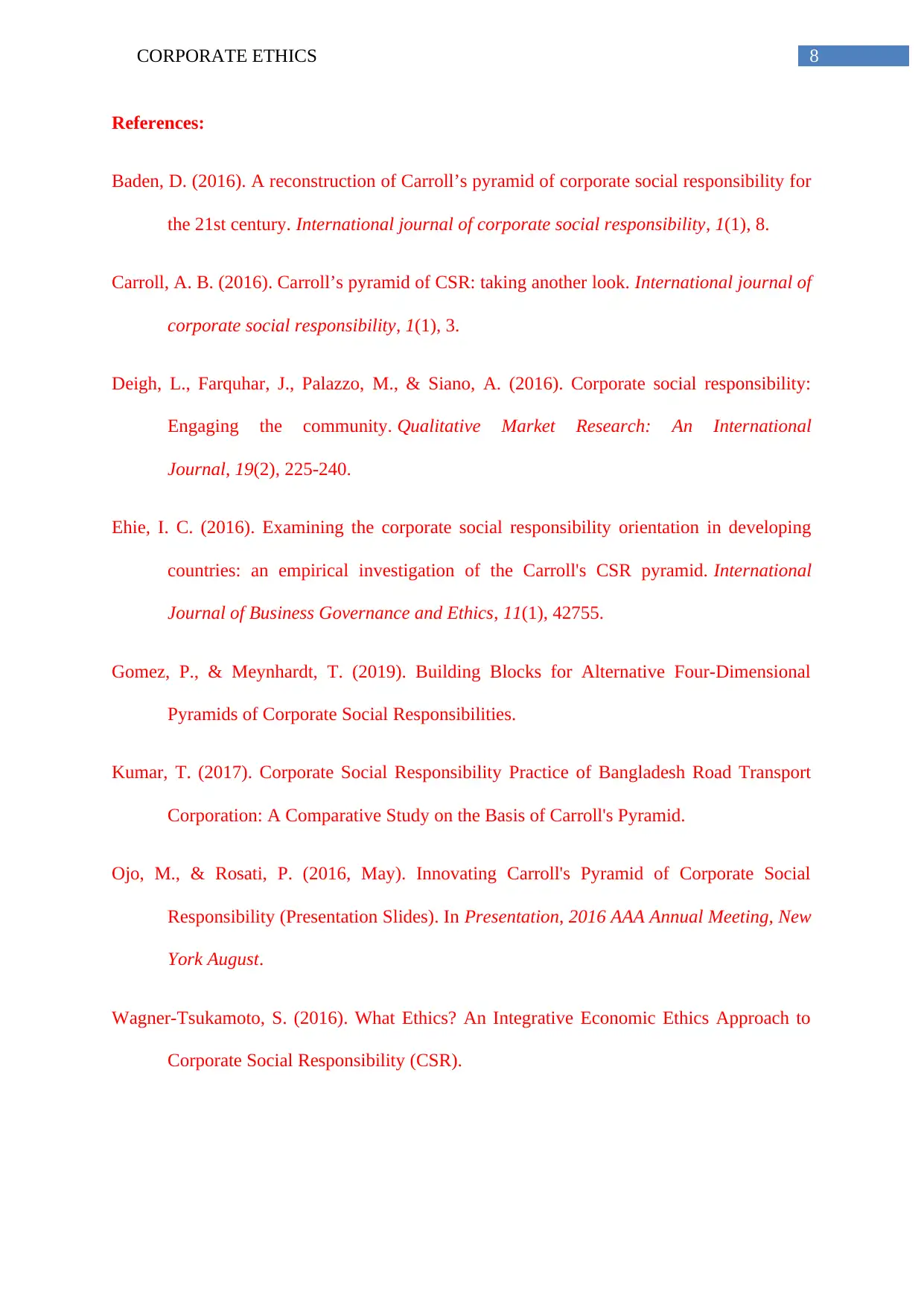
8CORPORATE ETHICS
References:
Baden, D. (2016). A reconstruction of Carroll’s pyramid of corporate social responsibility for
the 21st century. International journal of corporate social responsibility, 1(1), 8.
Carroll, A. B. (2016). Carroll’s pyramid of CSR: taking another look. International journal of
corporate social responsibility, 1(1), 3.
Deigh, L., Farquhar, J., Palazzo, M., & Siano, A. (2016). Corporate social responsibility:
Engaging the community. Qualitative Market Research: An International
Journal, 19(2), 225-240.
Ehie, I. C. (2016). Examining the corporate social responsibility orientation in developing
countries: an empirical investigation of the Carroll's CSR pyramid. International
Journal of Business Governance and Ethics, 11(1), 42755.
Gomez, P., & Meynhardt, T. (2019). Building Blocks for Alternative Four-Dimensional
Pyramids of Corporate Social Responsibilities.
Kumar, T. (2017). Corporate Social Responsibility Practice of Bangladesh Road Transport
Corporation: A Comparative Study on the Basis of Carroll's Pyramid.
Ojo, M., & Rosati, P. (2016, May). Innovating Carroll's Pyramid of Corporate Social
Responsibility (Presentation Slides). In Presentation, 2016 AAA Annual Meeting, New
York August.
Wagner-Tsukamoto, S. (2016). What Ethics? An Integrative Economic Ethics Approach to
Corporate Social Responsibility (CSR).
References:
Baden, D. (2016). A reconstruction of Carroll’s pyramid of corporate social responsibility for
the 21st century. International journal of corporate social responsibility, 1(1), 8.
Carroll, A. B. (2016). Carroll’s pyramid of CSR: taking another look. International journal of
corporate social responsibility, 1(1), 3.
Deigh, L., Farquhar, J., Palazzo, M., & Siano, A. (2016). Corporate social responsibility:
Engaging the community. Qualitative Market Research: An International
Journal, 19(2), 225-240.
Ehie, I. C. (2016). Examining the corporate social responsibility orientation in developing
countries: an empirical investigation of the Carroll's CSR pyramid. International
Journal of Business Governance and Ethics, 11(1), 42755.
Gomez, P., & Meynhardt, T. (2019). Building Blocks for Alternative Four-Dimensional
Pyramids of Corporate Social Responsibilities.
Kumar, T. (2017). Corporate Social Responsibility Practice of Bangladesh Road Transport
Corporation: A Comparative Study on the Basis of Carroll's Pyramid.
Ojo, M., & Rosati, P. (2016, May). Innovating Carroll's Pyramid of Corporate Social
Responsibility (Presentation Slides). In Presentation, 2016 AAA Annual Meeting, New
York August.
Wagner-Tsukamoto, S. (2016). What Ethics? An Integrative Economic Ethics Approach to
Corporate Social Responsibility (CSR).
⊘ This is a preview!⊘
Do you want full access?
Subscribe today to unlock all pages.

Trusted by 1+ million students worldwide
1 out of 9
Related Documents
Your All-in-One AI-Powered Toolkit for Academic Success.
+13062052269
info@desklib.com
Available 24*7 on WhatsApp / Email
![[object Object]](/_next/static/media/star-bottom.7253800d.svg)
Unlock your academic potential
Copyright © 2020–2025 A2Z Services. All Rights Reserved. Developed and managed by ZUCOL.





